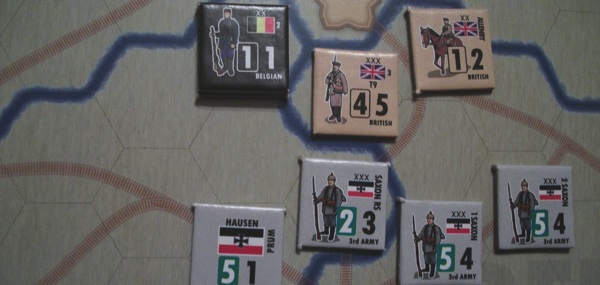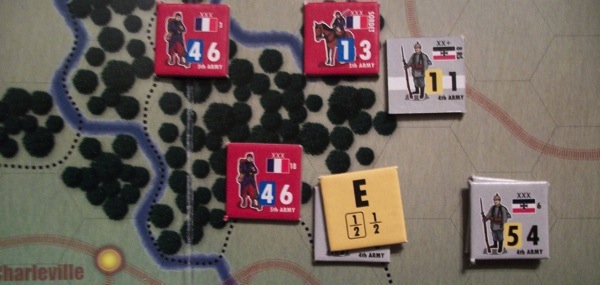Guns of August – Boardgame Review
 Guns of August. Boardgame. Publisher, Worthington Games. Designers, John Gorkowski and Grant Wylie. $50.00
Guns of August. Boardgame. Publisher, Worthington Games. Designers, John Gorkowski and Grant Wylie. $50.00
Passed Inspection: Great graphics, well-designed simulation of early WWI mobilization
Failed Basic: Ridiculously light hexes on the map, defensive artillery poorly handled
In their relatively short history, Worthington Games has produced some nice historical wargames, games with simple rules and good graphics. Guns of August is their entry into the First World War, and overall it’s a good entry but they left a few things back in the communications trench.
{default}Actually, there are no trenches in the game. Guns of August covers the opening weeks of the war on the Western Front when armies sought to outmaneuver each other and cavalry units still had a role to fill. To simulate this period, the game comes with two 11 x 30–inch, full-color map sections (forms a 22 x 30–inch map) representing northeast France, Belgium, and the northwestern border of Germany. The game includes 264 full-color counters representing French, British, Belgian, and German units, along with informational markers. About half of the units are double-step, half are single-step. You also get two full-color player aid cards (terrain effects and combat tables), and an eight-page rulebook that tells you how to use it all.
As with the other Worthington releases, there’s no risk of the rules getting in the way of the game. It’s a basic, old-school wargame with ZOC (We’ll get to a rant on ZOC in this game later.) and an odds-based combat chart. Units move hex by hex, paying costs based on terrain. Entering an enemy ZOC costs two extra movement points. Adjacent units engage in combat, which is resolved by comparing attack strength to defense strength and rolling 1d6. So far, so good.
Set-up can be historically based—army headquarters set up in hexes marked on their counters, and the corresponding army units set up within three hexes of the headquarters—or players may use a "what if" set-up and place army headquarters as they wish, with the units of that army still within three hexes.
Turns are based on a chit-pull system. To allow players to easily identify units of the different armies within each nationality, every army has a different color box around the unit’s artillery score, and the army is indicated on the counter as well. Each army has its own activation chit; at the start of the game all of the armies in play have their chits put into an opaque container. To start each turn, draw a chit at random; that army’s units can move and attack. Continue drawing chits at random until all of the armies have acted, at which point the game turn is over. Put the chits back in the cup, advance the turn marker, and then start drawing army chits again.

When an army is activated by a chit draw, its units can move and then attack. Stacking is easy: you can fit nine "X"s in a single hex. So a full-strength corps (XXX) can stack with two other full-strength corps; four reduced-strength XX corps can stack with a single X unit, and so on. Every full-strength (not reduced or exhausted) unit exerts a ZOC into the six adjacent hexes; enemy units must pay two extra movement points to enter those hexes. Opposing units cannot stack with each other unless one stack is inside a fortress.
Combat follows movement and has two steps, Artillery Combat and Rifle Combat. Each unit has an Artillery Score and a Rifle Score. Artillery duels open the fighting. Compare the attacker’s artillery rating to the defender’s and express as an odds ratio (1-1, 3-1, etc.), rounded in favor of the defender. Roll a d6 and consult the Artillery Table. Results can be 0 (no effect), S (defender is suppressed and suffers a column shift in Rifle Combat), or S1 (defender is suppressed and loses one step from the stack). Next comes Rifle Combat, which is also handled as an odds ratio on a Combat Results Table. Results apply to both attacker and defender and can range from No Effect to Two-Step Loss. One of the more common results is Exhaustion (put an Exhaustion marker on the unit; its movement and combat scores are halved; remove the marker once the unit is no longer within an enemy ZOC).
A few scenarios allow you to re-play certain limited campaigns, or you can go for the whole 27-turn monster that will take many, many hours to finish. Throw in such things as fog of war—you can’t examine enemy stacks until during battle, and you can cover stacks with the provided "hidden movement" counters—French head-on attacks, and basic supply rules based on rail lines, and you have a happily uncomplicated game.
So that’s the basics. Now for the good news and the bad news.
First, cavalry is handled very well. They exert ZOC into their neighboring hexes, forcing enemy units to pay an extra two movement points. Then they can immediately retreat one hex (during the opposing player’s turn) as long as the enemy stack does not contain cavalry units of its own. This really brings to fore the cavalry’s role as a recon and screening force.
The game is designed around staggered mobilization. On the first turn, each side can move and fight with only one unit. On turn two each side can move and fight with three units; turn three, it’s four units, and thereafter it’s no-holds-barred, use-all-your-counters. Strategic rail movement doesn’t begin until game turn nine. Along with the schedule of reinforcements and replacements, these rules give the game a feel like the slow start to World War I and show the depth of research that went into the design.
If only Worthington went that deeply into the map printing. When I first unfolded the mapboards I thought this was an area movement game. I’ve played through it a few times, and I’m still pretty sure it’s area movement—the hexes are printed so lightly as to be a literal afterthought. The fact that the units are slightly larger than the hexes doesn’t help things. You’ll find yourself moving units with guesswork unless you put your face to the map. Worthington offers a "dark hex" download on their website, but for fifty bucks I don’t want to have to print out my own two-foot by three-foot map.

Nice counter art, but the map hexes are ridiculously light.
The artillery rules don’t make much sense. A unit with an artillery factor of 2 attacks a unit with an artillery factor of 6. At 1–3 odds, the attacker has no chance to suppress or damage the defender before rushing in with foot soldiers and cavalry. But what about the defensive artillery fire? If they have a 3 to 1 advantage in guns, can the attack go off at all? The best remedy I’ve found is to have a round of offensive artillery fire, THEN a round of defensive artillery fire, and if the attackers suffer suppression no attack is made.
Likewise, there’s a problem with the siege rules. You besiege a fortress by moving a unit into its hex, then rolling 3d6 and adding them together. If the total is equal to or less than the current game turn, the fortress is destroyed; otherwise, there is no effect. So, on turn 12 the fortress is fine on a roll of 13, but on turn 13 it is wiped off the map with the same roll? All fortresses collapse automatically on turns 18 and later? I suggest rolling two six-sided dice and the fortress is destroyed on a nine or higher; add one to the roll for each turn the fortress has been besieged before the current turn.
I promised you a ZOC rant. ZOC means Zone Of Control, as any wargamer knows. In this game, they call it Zone Of Confusion. I’m not sure why. Zone Of Control has worked for thousands of games over the past several decades. Don’t go changing it now.
Overall, Guns of August is a good effort at a First World War game. The cavalry and mobilization rules feel right, I’ve always been a fan of the chit-pull unit activation (props out to ICE and their game Battle of Five Armies where this mechanic first appeared), and the rules cover game play while not interfering with playing the game. But the rules on artillery in combat and on sieges could have been tightened up, and the map, although beautiful, is inexcusably non-functional with its invisible hexes.
Worthington Games is a publisher of fine wargames. Guns of August is a good release which needed a little more rules editing and definitely more quality control on the map printing in order to measure up to the previous Worthington releases. As it is, it’s still a decent game and a nice way to introduce new players to the hobby.
Armchair General rating: 70 (would have been closer to 80 but for the map)
Solitaire rating: 3 out of 5
About the Author
Sean Stevenson has been gaming since the SPI days of the late 70s. His gaming collection now includes over 1700 games. He has just opened a gaming shop in Pittsburgh, Pennsylvania.

